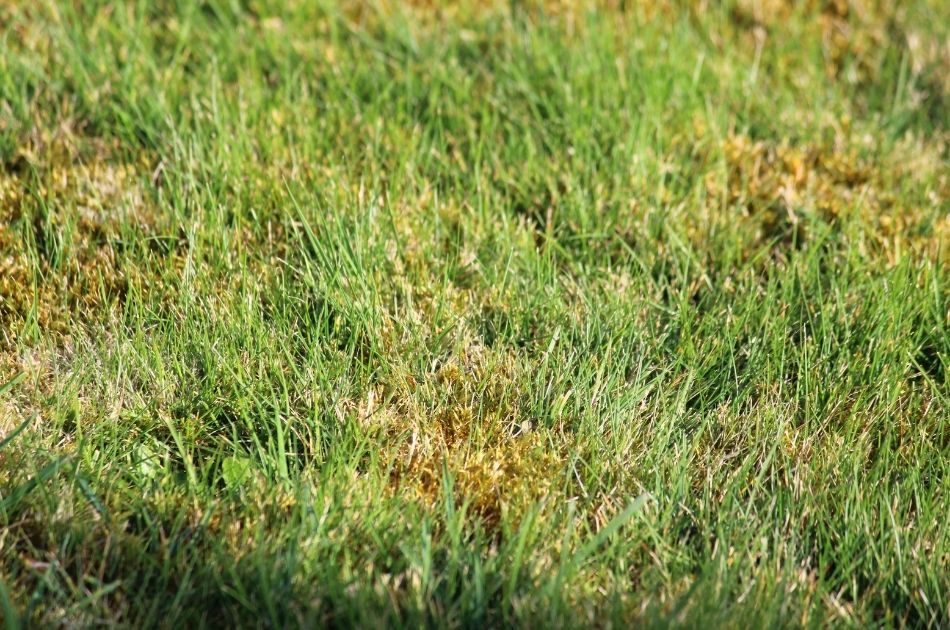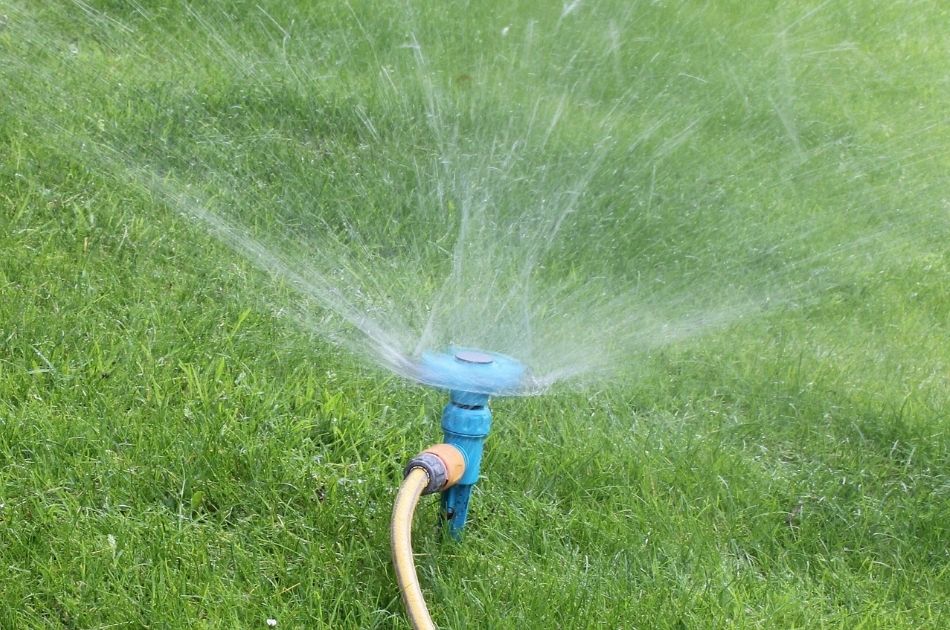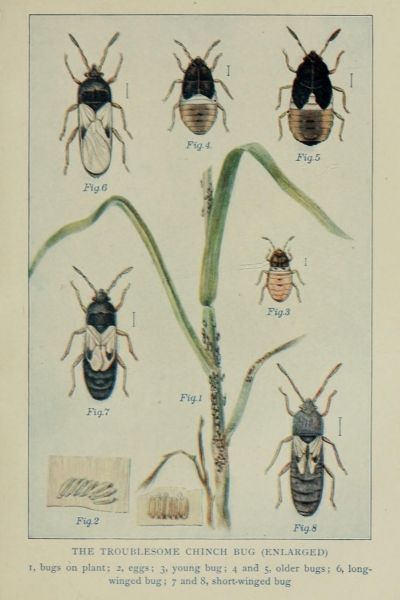Chinch bugs are common lawn pests in New Jersey and eastern Pennsylvania, where they kill turfgrass during the summer heat. If you find dead patches appearing in your lawn, despite watering it regularly, there’s a good chance you have a chinch bug infestation.
FAQs About Chinch Bugs in New Jersey Lawns
Below are answers to the questions customers most often ask about chinch bugs, including:
- signs of chinch bug damage,
- how to tell whether your lawn is infested with chinch bugs (rather than something else),
- when chinch bugs are most likely to attack your lawn,
- how to get rid of this lawn pest,
- ways to prevent future damage.

Close up of a hairy chinch bug. By Christina Butler from Georgia, United States – Hairy Chinch Bug – Blissus leucopteru, CC BY 2.0, https://commons.wikimedia.org/w/index.php?curid=104878164
What is a chinch bug?
Hairy Chinch Bugs (Blissus leucopterus hirtus) are common lawn pests in New Jersey and throughout the northeastern states. Because they are so small (often less than ¼” long) and hard to see, their populations can increase to infestation levels before you notice them.
Chinch bugs aren’t new; they’ve been around in the U.S. since the 18th century. Other species of the bug damage crops of corn, wheat, and sorghum, while the hairy chinch bug damages many types of turfgrasses.
Fun fact: Chinch bugs get their name from the Spanish word chinche, and the Latin word cimex.
How do I know if my lawn has chinch bugs?
Look for the telltale signs of chinch bug damage; spots or scattered areas of grass in your lawn that look dry and dead. These areas will often spread and merge into larger areas of damage.
Chinch bug damage can look like drought stress and often goes unnoticed at first. When the problem becomes obvious, many people increase their lawn irrigation thinking the insect damage is water stress. Unfortunately, more water won’t solve the problem.
How do chinch bugs kill lawns?
Chinch bugs cause great damage to your lawn by piercing grass blades with their piercing mouthparts. Once the bugs have pierced the grass, they suck out leaf juices, which dries the grass blade out. The bugs also release a toxin while feeding which can kill the grass.
This feeding damage leaves behind areas of dying and dead grass blades. The damaged areas will enlarge as the chinch bugs increase in number and spread throughout your lawn.
When do chinch bugs usually appear?
Chinch bugs overwinter in your lawn’s thatch and emerge with warm spring temperatures. Chinch bugs like heat, and by late spring or early summer, their populations will be very active.
By mid-summer, adult female chinch bugs will have laid eggs for the year’s second population, which will hatch in late summer.
Because chinch bug damage happens as temperatures rise and as stressed, cool-season lawns go dormant, it can be harder for people to identify chinch bugs as the cause of their areas of dead lawn.
How can I tell if there are chinch bugs in my lawn?
If your lawn is well irrigated and you still find small spots or large areas of dry-looking grass, you might have chinch bugs.
You’ll need to look closely to find chinch bugs in your grass. Lie on your lawn or rest on your hands and knees, and part the blades of grass. Looking closely, you should be able to see the tiny bugs as they move around.
You may see both adult chinch bugs and nymphs (young, immature bugs). Adult chinch bugs are black and may have white wings, while nymphs can be orange, red, or black with a white stripe.
The bugs will be down near the base of the grass blades. The best place to look for chinch bugs is at the edges of a damaged area of lawn where it meets healthy, green grass.
You can also use other methods to be sure you have chinch bugs:
- Cut the top and bottom off a metal can and push the can down hard into your grass so that it reaches the soil (wear gloves so you don’t cut your hand on the sharp edge of the metal). Then fill the can with water (a can that you’ve pushed into the soil will make a seal and keep water from running out). If you have chinch bugs, they will float to the surface of the water.
- Cut out a piece of damaged turf with a turf-cutting tool or knife. Be sure to include a bit of healthy turf, as chinch bugs are actively moving from damaged areas to “greener pastures” (healthy areas of your lawn). Put your piece of cut-out turf into a bucket filled with water. Chinch bugs will float up to the water’s surface. You can then replace the piece of turf and keep it irrigated so it will grow back into your lawn.

Do chinch bugs prefer certain types of turfgrass?
The hairy chinch bug likes several types of common turfgrasses, including:
- Bentgrass
- Fine fescues
- Kentucky bluegrass
- Perennial ryegrasses, and
- Zoysiagrass.
If you have a lawn that’s a mixture of grass types, as many people do, a mix with more than 50% Kentucky bluegrass will be attractive to chinch bugs.
How do chinch bugs spread?
As a chinch bug population grows, the bugs naturally expand their range as they look for new grass blades and stems to feed on.
Adult chinch bugs have wings and can fly, but much of the time they walk over and through your lawn.
When adult female chinch bugs lay their eggs in summer, they look for a safe place in the grass. When these eggs hatch, the offspring will head to healthy grass to begin feeding.
You may also see chinch bugs walking across driveways and sidewalks as they search for food and for overwintering sites.
Chinch bugs that overwinter will usually stay in your lawn, protected by thatch. They may also find another sheltered place, such as under evergreen shrubs and around your home’s foundation. They will emerge in spring and look for food (your healthy lawn).
How can I prevent chinch bug infestations?
Chinch bugs are drawn to stressed lawns and heavily thatched lawns. The best prevention for infestations is to keep your lawn sufficiently irrigated and dethatched. These two practices alone can help to keep chinch bug populations at a manageable level.
Dethatching Your Lawn
Keeping your lawn de-thatched is a good practice whether or not you have chinch bugs. Overall, it will make your lawn less attractive to harmful bugs.
Removing thatch also reduces the chances that female chinch bugs will lay eggs and that chinch bugs will overwinter in your lawn.
Irrigating Your Lawn
Irrigating your lawn on the right schedule for your lawn type and location will keep it green and healthy through summer’s hot weather. It’s also worth noting that chinch bug activity is reduced when there is a lot of natural rainfall, as many chinch bug nymphs drown in the water.
Mowing Your Lawn to the Right Height
Mow your lawn regularly and keep its height as high as recommended for your grass species. This will help keep moisture in your lawn and in your soil. It will also help moderate the soil temperature, which will discourage chinch bugs from moving in (they like it hot and dry).

How can I get rid of chinch bugs in my lawn?
A good way to get rid of chinch bugs is through regular lawn management, including moderate fertilization to keep your grass outgrowing chinch bug damage.
Don’t over fertilize though. Too much nitrogen can increase chinch bug infestation and can cause other, larger problems such as fertilizer runoff.
The best long-term approach to a healthy lawn (and trees and shrubs) is by maintaining healthy soil, regular irrigation, and proper mowing.
You can also encourage beneficial predators to visit your lawn (and your garden). Low populations of chinch bugs in a healthy lawn may be controlled naturally by insect predators that eat chinch bugs, such as:
- Ground beetle species
- Big-eyed bugs (Geocoris species).
Be sure not to use harmful chemical treatments that kill indiscriminately. If you wipe out populations of beneficial insects, you’re more likely to see a surge in garden pests.
How do I treat chinch bug infestations?
If you’ve followed all the best practices for a healthy lawn described above but still find you have chinch bugs, you may need professional lawn treatments to target and destroy the pests. This isn’t a DIY treatment so call a lawn care service to take care of the problem. Organic Plant Care LLC offers a full range of environmentally friendly lawn treatments, including for chinch bugs.

An illustration from an agriculture book for children, published in 1914, shows drawings of a variety of chinch bugs.
When should I treat my lawn for chinch bugs?
Summer is the best time to treat your lawn for chinch bugs. This is when lawns have the greatest number of bugs and you can reduce the population of immature chinch bugs before they reproduce.
If you have a heavy infestation, your lawn may need a second treatment 2-3 weeks later.
Note: You can treat your lawn for chinch bugs in the spring as well, when the bugs are just starting to spread. But if spring weather is cool and wet, treatment may not be necessary; the chinch bugs may die naturally as they don’t like these conditions.
Can the lawn damage from chinch bugs be reversed?
After the bugs have been controlled, you may need to restore your lawn. This will improve the health of your lawn overall and fill in areas of turf that were killed by chinch bugs.
How to Restore Your Lawn
The best time for lawn restoration is in the late summer. You can also restore your lawn in early spring when new grass is starting to grow.
Restoring your lawn is done through a series of steps. These steps include:
- Testing your soil to ensure its nutrient level is right for lawn growth
- Weed control that doesn’t kill beneficial insects
- Mowing your existing lawn down as low as possible and removing all thatch
- Careful soil preparation, including raking, smoothing, moderate fertilizing, and core aeration
- Seeding, using the right mix of grasses for your location and sun orientation
- Irrigating regularly to maintain even soil moisture without saturation or drying (new grass seeds will have very small, shallow root systems)
- Mowing to keep the grass short enough for sunlight to reach new grass shoots.
Lawn restoration can be a labor-intensive job, and many people choose to hire lawn care professionals to do the work. If you need help with lawn restoration, please give us a call; we’re highly experienced at fixing lawns using organic materials and practices.
We Can Help
Chinch bugs are serious lawn pests that won’t go away on their own. For heavy infestations, you’ll need professional lawn treatments to manage the pest.
Organic Plant Care LLC offers a comprehensive range of pest management services for your lawn. We can keep your lawn (and your trees and shrubs) vigorous and healthy year-round, and our Integrated Pest Management (IPM) methods mean your yard will be a safe and non-toxic place for everyone to enjoy this summer.
GET THE LATEST NEWS
Subscribe to the Organic Plant Care Newsletter and get timely and helpful tips and updates monthly.
There's no spam - we promise!





